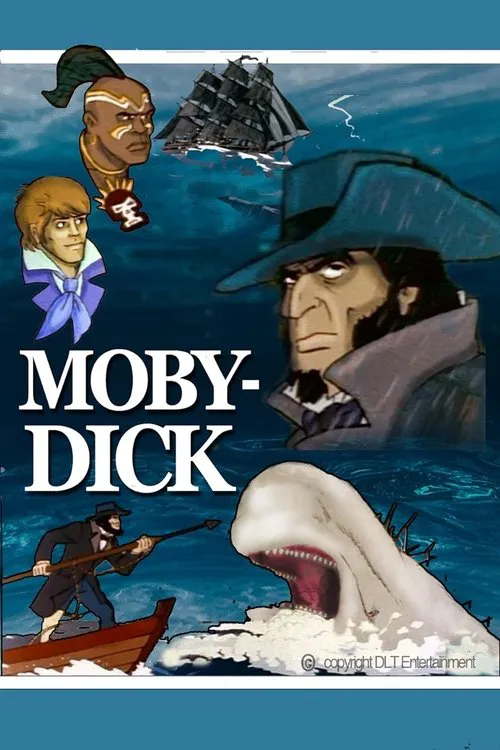Moby-Dick

Plot
It was on a bleak, stormy day in 1841 when Ishmael, a young and adventurous sailor, arrived in the bustling port of Nantucket. Drawn to the sea by a sense of wanderlust and a desire for excitement, Ishmael had decided to sign up on a whaling voyage aboard the ship Pequod. As he strolled along the dock, trying to decide which vessel to join, he encountered a fellow sailor named Queequeg, a skilled harpooneer from a remote Pacific island. Despite their initial reservations about each other's cultures and backgrounds, Ishmael and Queequeg quickly formed a strong bond, one that would stand the test of time and hardship. The two sailors finally settled on the Pequod, a sturdy three-masted whaler captained by the gruff and seasoned navigator, Captain Ahab. Ahab was a complex and enigmatic figure, whose leg had been lost in a previous encounter with a colossal white whale named Moby Dick. Consumed by a fierce hatred and a sense of vengeance, Ahab had become obsessed with hunting down the elusive creature, determined to extract his revenge and reclaim the limb that had been brutally torn from his body. As Ishmael and Queequeg embarked on their journey, they were swept up in the Pequod's crew, a diverse and motley group of men from various backgrounds and cultures. There was Flask, a young and ambitious sailor who aspired to rise through the ranks; Stubb, a wise-cracking and somewhat arrogant mate who served under Ahab's command; and Starbuck, a seasoned harpooneer and Ahab's trusted second-in-command. Together, the crew set sail for the open ocean, driven by the promise of whales, adventure, and riches. The Pequod's course was guided by Ahab's unyielding determination to track down Moby Dick, a whale so massive and elusive that it had become the stuff of legend. As the crew sailed further and further from land, the air grew thick with the scent of salt, sea spray, and the promise of adventure. Ishmael and Queequeg quickly became an integral part of the crew, learning the ins and outs of whaling and sharing in the camaraderie of their shipmates. However, beneath the surface of their lives at sea, a sense of foreboding and unease had begun to simmer. Ahab's all-consuming quest for revenge against Moby Dick seemed to be driving the ship and its crew further and further into danger. His fixation on the white whale appeared to be bordering on madness, with Ahab risking the lives of his crew members in his relentless pursuit of the creature. As the Pequod sailed the vast expanse of the ocean, Ishmael found himself drawn into Ahab's orbit, caught up in the captain's whirlwind of emotions and events. Despite his own misgivings about Ahab's sanity and motivations, Ishmael couldn't help but be fascinated by the captain's unwavering resolve and unshakeable will. He began to see the world through Ahab's eyes, to understand the depths of the captain's pain and the depths of his obsession. Yet, as the days turned into weeks and the weeks into months, the crew of the Pequod began to realize that Ahab's quest was taking a toll on the very fabric of their lives. Whales were being hunted and harpooned, their massive bodies dragged aboard the ship for processing. But with each kill, Ahab's obsession only seemed to grow, his desire for revenge against Moby Dick driving him further and further into the jaws of madness. In the midst of this turmoil, the relationship between Ishmael and Queequeg continued to deepen. The two sailors grew closer, sharing a bond that transcended their cultural differences and their individual backgrounds. Together, they navigated the treacherous waters of the Pequod's crew, always on the lookout for signs of tension or conflict. As the story hurtles towards its inevitable conclusion, Ishmael finds himself face to face with the very real possibility of disaster and destruction. Ahab's quest for revenge has drawn the Pequod into the heart of a maelstrom, a swirling vortex of chaos and destruction that threatens to engulf the entire crew. In the end, it is this same vortex that ultimately claims the Pequod, dragging the ship and its crew down to a watery grave. Moby Dick, the white whale of legend, emerges as a symbol of the unconquerable power of nature, a reminder to Ahab and his crew of the impossibility of human control and the fury of the sea. As Ishmael's ship disappears beneath the waves, he finds himself clinging to a wooden coffin, his thoughts consumed by the horrors he has witnessed and the tragedy that has befallen the crew of the Pequod. As he looks out into the distance, he sees the massive form of Moby Dick, gliding through the water with a sense of power and majesty that is at once haunting and awe-inspiring. In the aftermath of the disaster, Ishmael is left to ponder the lessons of the Pequod's ill-fated voyage. He comes to realize that Ahab's obsession with the white whale was a manifestation of his own flaws and vulnerabilities, a reminder of the dangers of unchecked ambition and the fragility of human existence. The story of Moby-Dick comes full circle, as Ishmael reflects on the nature of man and the mystery of the sea. In the end, it is not the white whale that has claimed the Pequod, but the very same hubris that had driven Ahab to pursue it.
Reviews
Recommendations



